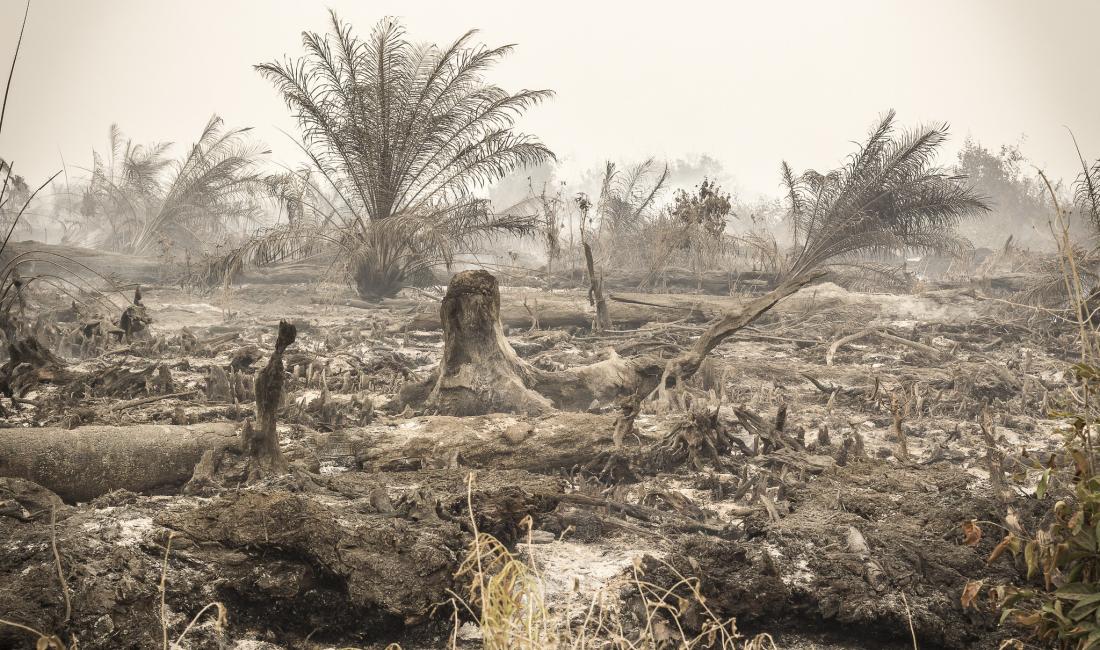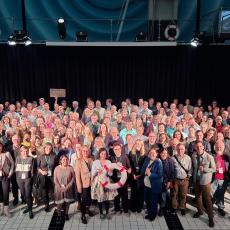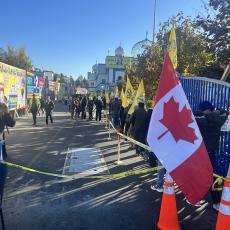A village of trees and waters now is surrounded by plantations
This investigative story was produced and published by Asia Democracy Chronicles. This piece is the second of a two-part series. Photo by Friends of the Earth International
Adi Renaldi Daniela Sala Budi Baskoro
Indonesia, the world’s top exporter of palm oil, currently grapples with the complex realities of an industry that fuels its economy while cloaking its skies in smoke.
While palm oil – an ubiquitous product used from cooking to cleaning – brought in US$24 billion in revenue in 2023 and boasts of lifting as many as 10 million Indonesians out of poverty between 2001 and 2010, it is also hounded by accusations of deforestation and environmental destruction as companies and illegal oil-palm farmers clear forests even in protected areas.
Every year, between September and October, haze enveloping cities as far as those in Singapore and Malaysia, and sometimes even in the Philippines, is blamed on the illegal, large-scale slash-and-burn methods adopted by some Indonesian oil-palm plantations.
In the villages that have been forced to host oil-palm plantations, big and small, few are also happy about an industry that is now giving them livelihoods. They agree that the industry has changed their lives, but not quite in a good way.
“Before oil palm plantation came to Bangkal village, our life was about farming, hunting, then catching fish in rivers or lakes,” smallholder oil-palm farmer James Watt told Asia Democracy Chronicles (ADC). “Before there were oil palm plantations, there was a huge difference. Back then we were self-sufficient. We didn’t buy commodities that much. We didn’t buy vegetables. We didn’t even buy fish. Now, you have to buy everything.”
Bangkal is a remote village established at the end of the 17th century on the banks of Sembuluh Lake, the largest in Indonesia’s Central Kalimantan province. With an area of almost 8,000 hectares, the lake is an estuary for rivers that flow through Central Kalimantan and has been an important source of livelihood for generations. It also helped make Bangkal emerge as one of the region’s important economic hubs.
Watt, 54, echoed other villagers in recalling a Bangkal that was once surrounded by pristine forest, crystal-clear lake, and farmland. Sembulah Lake was then the center of many of their activities – they caught fish from it, and bathed and washed clothes in it.
The residents grew vegetables, rice, and fruit on their land, and hunted boars and deer for meat in the forests. The resin and rattan that villagers sold around Central Kalimantan also came from the forests.
Today, instead of trees, Bangkal is surrounded by oil palm plantations. The first company to cultivate oil palm there was PT Agro Indomas in the 1990s. In 2005, PT Hamparan Masawit Bangun Persada (HMBP) secured a license from then Central Kalimantan regent Darwan Ali to turn almost 13,000 hectares of land in the area into oil-palm plantation.
Bangkal village leader Sangkai Rewa, 58, said residents have been resisting the intrusion of palm oil companies into their communities since the 1990s, believing that the palm oil industry would only cause destruction and alter their way of life.
“Everything happened suddenly, without any consultation with the community,” Rewa said. “The people of Bangkal were forced to give up their land through threats and deception. Around us it was all forest. Look around you: what happened today?”
Murky waters
At the very least, it’s hard to reconcile present-day Sembuluh Lake – now smothered by water hyacinths – with the gushing descriptions of older villagers. According to the locals, the rapid expansion of the palm oil industry and mining activities in the upstream area of rivers have caused heavy pollution of the lake.
Observers, meanwhile, say that the use of herbicides, fertilizers, and pesticides by oil-palm plantations and smallholder farmers has contributed to the lake’s degradation.
Wardian, a 68-year-old farmer in Sembuluh I village, which also sits near the lake, remarked that no one would ever want to bathe in it anymore, unless they want to contract skin problems. He added that there used to be at least 44 types of fish in the river and the lake; now four or five types have gone extinct. Local fishers’ catch has been decreasing over the years, Wardian said.
“Today, if you throw a fishing net in the lake, you will catch sewage,” he said. “The fishing net will be full of black substance, like oil, a sign that there is contamination in the water.”
“There is a change in color and then a change in taste, which according to the residents made it impossible for them to consume it,” said Muhammad Habibi, director at the local environmental NGO Save Our Borneo. “Then they also said they could no longer use the lake water in their various activities.”
In 2018, Save Our Borneo forwarded the villagers’ complaints to the Seruyan Environmental Agency. But the local government body said that Sembuluh Lake was not polluted.
Research conducted by the Ecological Observation and Wetlands Conservation (Ecoton) in 2020 in West Kalimantan also showed severe degradation of the upstream area of Sambas River, which is surrounded by at least three palm oil companies. Ecoton recorded at least 25 types of species in the river, with at least one type of species being threatened.
Water quality monitoring by the organization at 57 sites around Sambas River also showed that almost 70 percent of the sites had water quality below the national standard, with high free chlorine levels between 0.03mg/l and 0.67mg/l.
Higher levels of free chlorine concentration were found in canals and tributaries where palm oil plantations are located, Ecoton said. It also found concentration of phosphate of about 0.2mg/l, above the national standard, in canals and tributaries.
“Application of potassium chloride [MOP-fertilizer] and paraquat dichloride [herbicide] were suspected to be the source of chlorine contamination,” the Ecoton study said.
Killing more than weeds
Ecoton researcher Amiruddin Muttaqin told ADC that the herbicide was not 100-percent absorbed when it comes into contact with foliage. Thus, he said, there is a chance that it is absorbed by the soil and washed away by rainwater and into bodies of water, because canals inside the plantations will eventually flow to creeks or rivers.
“Fisherfolk and residents have reported decreasing fish stock,” Muttaqin said. “It is not uncommon for them to see schools of fish dead for apparently no reason. But it actually shows how polluted the river is.”
Paraquat, marketed under the brand Gramoxone, is not the only herbicide used by oil palm plantations. There is also glyphosate, commonly marketed under the brand RoundUp, which is owned by the German pharmaceutical giant Bayer AG. The yellowish glyphosate has been known to be extremely toxic for aquatic life and can contaminate surface water, and therefore should not be used in wetlands, including peatland, or near bodies of water.
The World Health Organization (WHO) said that it is “probably carcinogenic to humans,” and that for both “pure” glyphosate and glyphosate formulations there is “strong evidence” for genotoxicity.
In Central Kalimantan, however, it is paraquat that dominates. Watt said that Gramoxone “has been available since the palm oil companies came in. Here, Gramoxone means palm oil.”
Notorious for being toxic to mammals, including humans, paraquat has been banned in more than 60 countries across the world. It can also cause soil and water pollution. In a 2021 paper, a team of Chinese and Pakistani academics noted as well that the paraquat toxin ”can damage the immune system of fish through water, affect the regulation of cellular immunity and humoral immunity, and further damage other vital organs … such as liver and kidney.”
Watt said that Gramoxone was the first herbicide he had ever used. When he was still planting rubber, he would just cut down the weeds and burn them. But the government banned the slash-and-burn practice in the wake of large forest fires in the late 1990s.
Between the 1980s and the 2000s, farmers in communities around Sembuluh Lake shifted to rubber, which was being promoted by the then government. Watt, who previously grew rice on his four-hectare plot, was among the first to plant rubber in Bangkal. But then the price of rubber began fluctuating in the 2010s, and has continuously plummeted in the last decade. In 2023, a kilogram of raw rubber cost around IDR 7,000 (US$0.43), down 60 percent from the previous year.
“I planted rice paddy first,” said Watt. “After that, I planted rubber. Then the price of rubber fell. I worked on it again. Kept working on it again (and again). Then I cut it down and replaced it with oil palm.”
The price of prosperity
Oil palm certainly brings more stable income to farmers like Watt. Oil palm seed costs between IDR 25,000 (US$1.5) and IDR 48,000 (US$3) per tree, depending on the height and quality; a tree could live for 25 years before it needs replanting. Watt said he could harvest oil palm fruits once every 15 or 20 days.
He can also get about one ton of oil palm fruits each harvest, which can net him as much as IDR 2,500,000 (US$153). From the four hectares he had 11 years ago, Watt now has almost 14 hectares of land.
Yet that prosperity has come at a price. Oil palm cultivation has not only been changing Bangkal’s entire ecosystem and landscape, but it has also changed the way farmers there cultivate. Rubber plants do not require heavy maintenance, said Watt, whereas oil palm is the opposite. Unwanted weeds and plants must be eradicated frequently for oil palm to grow optimally, prompting local farmers to turn to herbicides.
Today herbicides like Roundup and Gramoxone can easily be found not just inside company warehouses but also in the pantries and backyards of smallholder farmers – and, as it turns out, in the soil and many water bodies in Central Kalimantan.
Activists have long criticized the agricultural sector’s dependency on toxic herbicides and government’s failure to provide alternatives. The Indonesian Forum on the Environment (WALHI) pointed out, for instance, that while there are regulations on herbicide use, their implementations are far from ideal.
“Herbicides and chemical fertilizers will also damage water sources and biodiversity, especially around large plantations,” said WALHI Central Kalimantan director Bayu Herinata. “It is important that in the future this is also accommodated in commitments or policies both at the international and national levels.”
“I think the first thing to do is to educate farmers about herbicides, giving them more information on the negative impacts,” said Achmad Surambo, director of the national NGO Sawit Watch. “Then the government should think about the alternatives by providing, for example, safer, organic herbicides.”
In the meantime, smallholder farmers who have little to no access to information on herbicides find themselves with limited options. “There is really no choice,” Watt said. ◉
This series received support from Journalismfund Europe.
Adi Renaldi, Daniela Sala, and Budi Baskoro are freelance journalists. Adi and Budi are based in Jakarta and Pangkalan Bun, Central Kalimantan, Indonesia, respectively, while Daniela is based in Rome, Italy.



